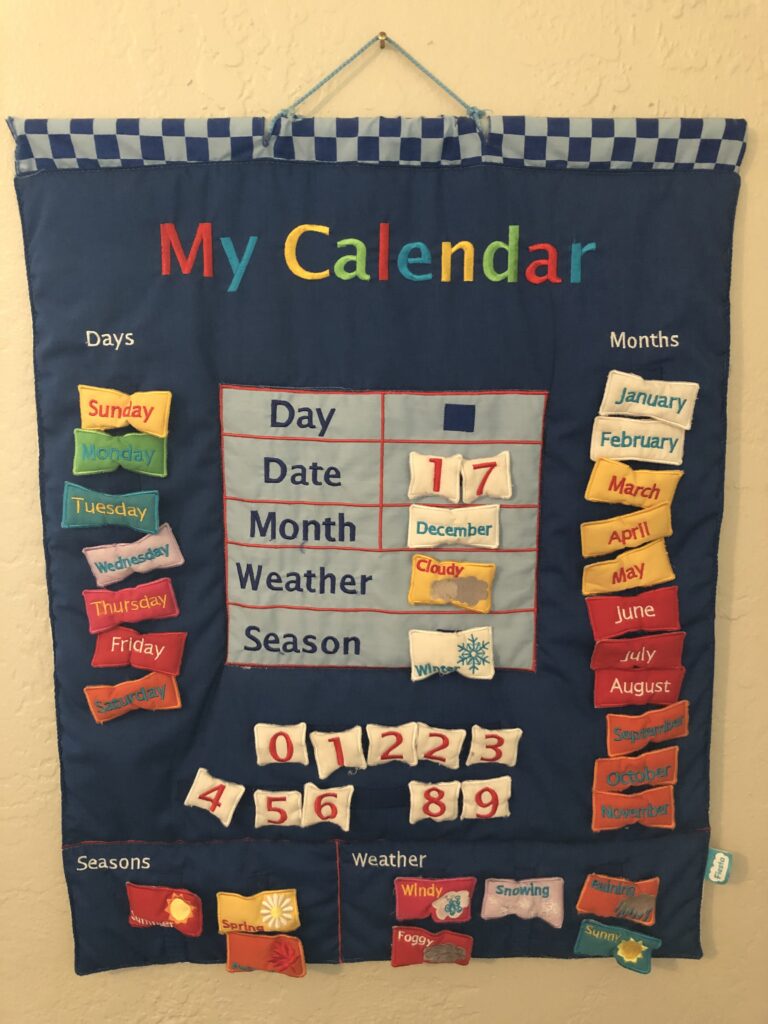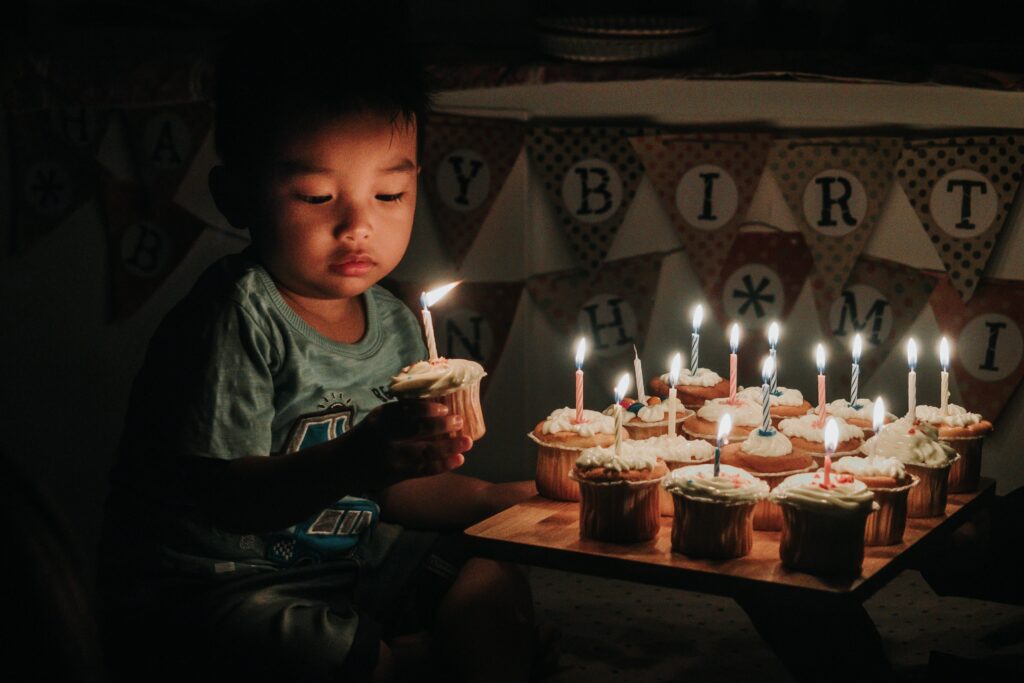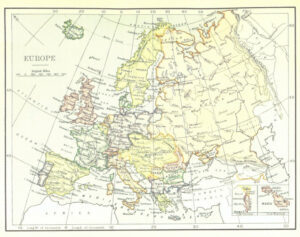“Mom, when is it going to be my birthday?” my three-year-old asks.
“Well, in September it is Ollie’s birthday, October is Halloween, November is Thanksgiving, Christmas comes in December. Then, it’s your birthday in January!”
“How many days?”
“Hmm…about 120.”
“That’s a long time!” my youngest wails. “Ollie gets presents now.”
Trying to explain the concept of time to a three-year-old is a losing proposition. Birthday conversations like this almost always end in tears.
My son could understand before and after, but that was about it. Maybe a calendar routine would help?
One day at Costco, I discovered an interactive Velcro calendar for children. It was perfect! So, I decided to start a calendar routine with my three-year-old. After all, the daily calendar routine was a consistent, effective part of my teaching day when I taught first and second grade. I used a daily calendar routine to teach and reinforce the days of the week, months of the year, and the seasons. I even used it to teach mathematical patterns, counting by tens, and exploring weather patterns in our region. Why not try it with my son?
As a result of our daily calendar routine, my son developed a better sense of time, he learned the days of the week and months of the year, and he even learned to recognize numbers and look at initial letter sounds to identify which day of the week or month of the year to put on the calendar. There are many learning benefits when you start a calendar routine with your children.
The Importance of a Calendar Routine

According to Susan A. Miller, EdD,”three and 4-year-olds need to have lots of meaningful experiences with time in a personal sense (bedtime, storytime) to gain a clearer understanding of temporal ideas.”
Routines help preschoolers begin to understand the concepts of before and after and what happens next in the day. Routines are reassuring for young children. Routines make them feel safe. They help the world feel more predictable. When preschoolers know what to expect, they feel more confident. A calendar routine will help your preschooler develop a better idea of time and how the world works.
For preschoolers, time concepts usually form around events. My son became interested in time when he wanted to know when it would be his birthday.
For five and six-year-olds, the concept of time is still abstract and rather difficult. “A sense of time is gained gradually during the process of living through timespans marked by events. As children experience the world of people and things, their concept of time becomes integrated into their everyday lives, as well as into their vocabularies.”
Therefore, to help our 3-6 year old children develop this sense of time, a regular calendar routine that marks the passage of time and highlights key events is hugely beneficial.
How to Implement the Calendar Routine
As parents, we are busy – especially in the morning! It can be difficult to establish a consistent calendar routine this time of day.
1. Keep it simple. Don’t try to achieve too many things with your calendar routine or you won’t be consistent. Start with the basics. If you need to, do your calendar routine the night before when things are calmer in the house.
2. Add your calendar routine to you child’s morning job chart. Check off the tasks on this chart each morning so you don’t forget any of them. This signals that the calendar routine is important and, if it is on the morning job chart, you will do it consistently. For more on morning routines, check out this post:
Win the Morning, Win the Day – Not With Young Children in the House
3. Start with a ‘days of the week’ song. See the videos below if you need more ideas. I’d like to give a shout out to Blanca Stingl, an amazing kindergarten teacher with a great calendar routine. I got many of these ideas from her. Give your child a pointer and allow him/her to point at the days of the week as you sing. When you introduce letter sounds, have your child look for the day of the week that starts with the ‘mmm’ sound (Monday).
4. Help your child select the number for the date. By doing this repetitively, your child will soon recognize numbers to 30.
5. Sing a ‘months of the year’ song. You may only want to do this a couple of times each month. If your child is getting bored or fidgety, keep your calendar routine shorter. Create a dance or let your child use the pointer for the months of the year to keep him/her moving.
6. Sing “What’s the weather like today?”. Then, look out the window and decide. Put up the appropriate weather label.
7. Finally, mention the season. You may want to read a book about ‘winter’ when the season changes. Discuss winter clothing, activities, and changes in the environment. You can do this each time a season changes. This can be a starting point for some great seasonal learning activities.
Videos of Calendar Songs
Here are some songs I’ve used in my classroom and at home with my sons. They are catchy and fun. Some days you may only have time for one of them. Other days, you may sing more. You can also sing these in the car or while you are waiting in line. See if your children can put their shoes on before you finish the months of the year song. There are many ways to incorporate these songs into your day.
Days of the Week Song (Addams Family)
For more ‘Days of the Week’ song options, check out my YouTube channel:
Extensions
Here are some ways to extend the calendar routine. I didn’t do many of these at home as a parent, but I did do them in my classroom. When your child starts to get bored with the calendar routine or needs a new challenge, you may want to introduce one of these ideas.
Mathematical Patterns: You can introduce mathematical patterns with a calendar. If you buy calendar cut-outs from a teaching supply store they typically have two colors on them (one on each side). So, as you put up a day you can introduce a pattern. I would start with a basic A,B,A,B pattern. If you have red and green apple cut-outs, simply alternate them as you put up the day of the week. You could then do an A,B,B, A,B,B patterns and put up red, green, green, red, green, green apples. If you use different shapes or pictures you could create a ghost, bat, witch, witch pattern for Halloween (A,B,C,C).
If you put up one day at a time, your child will love to start predicting the next color or shape in the pattern.
Teach the Tens: Counting by 10 is an important skill for young children. Once your child counts to 20 or 30 you can start teaching him/her to count by 10. It even helps to do this before you start counting to 100. It just makes counting to 100 easier because your child will already know what to do after 29 or 39.
To teach the tens with your calendar, use skinny straws. Each day, put a straw in a pocket. When you get to 10 straws, put a rubber band around them creating a group of 10. When you have several groups of 10, you can show your child how much easier it is to count by tens than to count each straw individually. You can start putting up straws when your child starts school. Or you can put up straws until you reach a special day, like your child’s birthday. This will make the passage of time less abstract as you mark each day with a straw. It always helps to use a visual to teach a concept like grouping and counting by ten.
Weather Graph: To teach graphing, you can create a weather chart. Use some graph paper and color in a box above the sun each time it is sunny. Color in a box above the word/picture for rain, each time it is rainy. You can start with a simple bar graph and over time introduce pie charts, line graphs, pictographs, etc. With a weather graph you can look for weather patterns and discuss what the weather is like during the different seasons.
Conclusion
There are many benefits to creating a calendar routine for children. A calendar routine helps your child start to understand the abstract concept of time and comfortably use the vocabulary associated with time. It will help your child anticipate events and mark milestones. A calendar routine even teaches number recognition and basic literacy skills.
You may want to read this post about using a calendar routine to teach responsibility for 6-11-year-olds:
Help Children Become Readers By Creating A Print-Rich Environment At Home






4 Responses
I don’t have kids at the moment, but I find these tips really interesting for when I will do. I have some friend who do so I will share with them your post! Thank you for sharing this 🙂
Audrey
Thanks, Audrey. I hope you friends with children find this post useful.
Wow, Becky, this is awesome, thank you!!
What a wonderful way to teach your children.
My grandchildren are 2 and 4, and I’d like to start this with the older one. That is if I can get him to sit long enough, lol.
I’m also sending your post to my daughter for inspiration.
Thanks again,
Suzanne
Thank you so much, Suzanne. I really appreciate your feedback. I hope your daughter finds this post useful 🙂